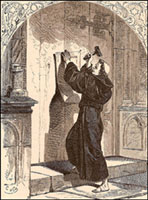THE COUNCIL OF TRENT MADE "PURGATORY" MANDATORY FOR CATHOLICS!! MANY POPES
BECAME CLOSET HINDUS BECAUSE THEY PREFERRED REINCARNATION OR RECYLCING TO ENDURING AN INDEFINITE STAY IN THE HOT AND DARK SUBTERRANEAN ZONE CALLED "PURGATORY!" |
Before the coming of the Messiah, Egypt was quintessentially Baalzebub's kingdom:
Which I commanded your fathers in the day that I brought them forth out of the land of EGYPT, from the IRON FURNACE , saying, "obey my voice, and do them, according to all which I command you: so shall ye be my people, and I will be your Elohim" (Jeremiah 11:4).
According to Catholic dogma, Purgatory is a fiery furnace in the bowels of the earth . . . but their "good news" is that some souls can be released early by the suffrages of the "Church Militant."
Purgatory is also found in the Latin Vulgate Version where the Greek word METANOEO (REPENT) is translated as PENANCE:
But he (rich man) said: No, father Abraham: but if one went to them from the dead, they will do penance (Saint Luke 16:3, Douay-Rheims Version).
The foundation of Purgatory was laid in Alexandria, Egypt, and it incorporates pagan Egyptian and Greek ideas of the underworld with a corrupt Bible translation!
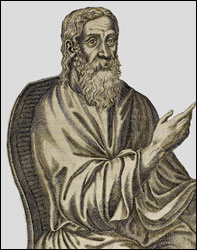 . .Clement of Alexandria (150–215). |
|
 No image exists of Origen of Alexandria. |
Here is a quote from a French Catholic author about the real origin of Purgatory:
Yet it was in this eschatological atmosphere that one pontiff, moved by an ardent pastoral zeal in a dramatically earthly context, fanned the purgatorial flame back to life, After Clement of Alexandria and Origen, after Augustine, the last "founder" of Purgatory was Gregory the Great (Le Goff, The Birth of Purgatory, p. 88).
It is no coincidence that North Africa was a great stronghold of true Christianity until the Saracen Muslim conquests.
 Augustine of Hippo Regius (395–430) writing the Koran. |
|
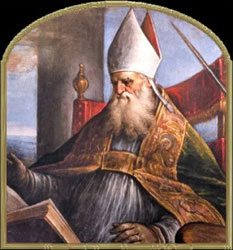 Pope Gregory I (540–604). Pope from 590 to 604. |
Islam has nothing to say about the afterlife except that there will be Day of Judgment at the end of time when everybody's eternal fate is decided.
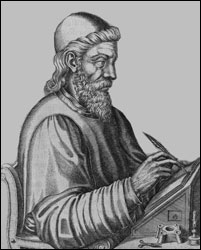 Benedictine monk Beda (672–735). |
|
 Boniface (675–754) was a zealous Purgatory promoter! |
As the prophetic year 1260 approached, the Popes were on steroids. That date was supposed to herald the dawn of the Third Era of the Holy Spirit. The Church of Roma also divided her members into 3 groups or sections: the Church Militant, the Church Suffering, and the Church Triumphant.
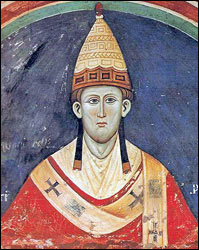 Pope "Innocent" III (1160–1216). Reigned from 1198 to 1216. |
|
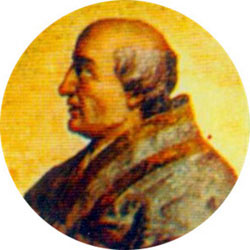 Pope Gregory X (1210–1276). Pope from 1271 to 1276. |
Here is another quote about the slow evolution of Purgatory:
It is beyond the scope of this book to trace the way in which scholasticism adopted and helped to establish Purgatory. The process lasted through the first three quarters of the thirteenth century, up to the time of the Second Council of Lyons (1274) which gave Purgatory official status among the doctrines of the Latin Church (Le Goff, The Birth of Purgatory, p. 237).
That Council was called in an effort to reconcile the Latin and Greek Churches. The addition of Purgatory only widened the great gulf.
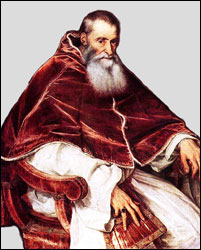 Pope Paul III (1468–1549). Pope from 1534 to 1549. |
|
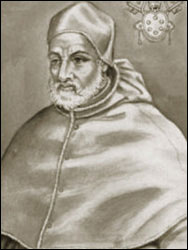 Pope Pius IV (1499 – 1565). |
Here is a quote from Canon XXX of the Council of Trent:
Canon 30. If anyone says that after the reception of the grace of justification the guilt is so remitted and the debt of eternal punishment so blotted out to every repentant sinner, that no debt of temporal punishment remains to be discharged either in this world or in purgatory before the gates of heaven can be opened, let him be anathema (accursed) (Council of Trent, Sixth Session).
Session XXV declared that the suffrages of the "Church Militant" could help the "faithful" departed:
The bishops shall see to it that the suffrages of the living, that is the sacrifice of the mass, prayers, alms, and other works of piety which they have been accustomed to perform for the faithful departed, be piously and devoutly discharged in accordance to the laws of the Church, and whatever is due on their behalf from testamentary bequests or other ways, be discharged by the priests and ministers of the Church and others who are bound to render this service not in a perfunctorily manner, but diligently and accurately (Council of Trent, XXV Session).
There never was any discrimination when it comes to the "Church Militant" because females play a more vital role than males!
The main goal of the suffragettes was votes for Catholic politicians who believe in Purgatory!
The suffragettes were a vital part of the "Church Militant," who wanted the Catholic dogma of Purgatory imposed by legislation.
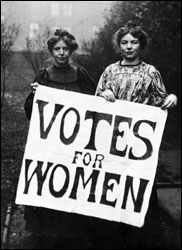
2 suffragettes holding a "Votes
for Women" sign in Britain. |
|
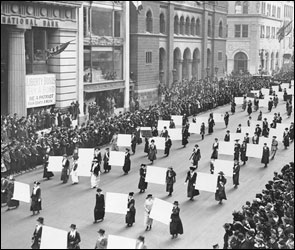
A suffragette parade in New
York City in 1917. |
"Votes for Women" had nothing to do with freedom for women....It was the work of the "Church Militant" to elect Catholic politicians who believed in suffrages for the souls in Purgatory....Unfortunately for them, here were not enough votes from women to send Alcohol Smith to the White House in 1929.
The suffragettes also believed that by working for suffrage it would shorten the time that they would have to spend in Purgatory!
Subsequent history has proved that those Catholic militants were highly successful because Hillary Digby Churchill Clinton almost became President of the New Jerusalem in 2017.
All the Popes are in Hades . . . except for Pope Clement XIV
It was the infernal issue of Purgatory that sparked the glorious Reformation in Germany. The issue back then was not "Votes for Women," but money to rebuild Saint Peter's Basilica in Roma.
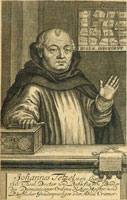 Dominican friar Johann Tetzel (1465–1519) with his coffer! |
|
The pompous, arrogant Dominican friar Johann (John) Tetzel came to town like the fake "Roman" emperor, with trumpets blaring, and he loved to repeat this little jingle to the credulous people:
AS SOON AS THE COIN IN THE COFFER RINGS,
THE SOUL FROM PURGATORY SPRINGS!
The real Saint's confrontation with Tetzel was the spark that ignited the blessed Reformation. It opened his eyes to the fact that the Papacy was indeed:
Mystery Babylon the Great, the Mother of Harlots and Abominations of the Earth" (Apocalypse (17:5).
In his magnum opus, published in 1620, Luther wrote that the Christian Congregation was taken captive by the Papacy (symbolized as Babylon) for the previous 1000 years. He proved from Scripture that there were not 7 sacraments . . . but 2: Baptism and Communion.
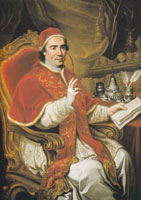 Pope Clement XIV (1705–1774). Pope from 1769 to 1774. |
|
 King Louis XV (1710–1774). Reigned from 1715 to 1774. |
After issuing the Bull of Suppression, Pope Clement died a horrible death by poisoning. If any Pope made it to heaven he is surely singing the song of the Lamb in the heavenly choir.
Take a spiritual purgative to rid your soul of the toxic idea of Purgatory!!
The Exodus from Egyptian bondage is a marvelous type of our salvation in Christ. JEHOVAH told the Israelites to kill a LAMB and sprinkle its blood on the doorposts of their houses:
For JEHOVAH will pass through to kill the Egyptians; and when he sees the blood on the lintel and on the two doorposts, JEHOVAH will pass over the door and not allow the destroyer to come into your houses to kill you (Exodus 12:23).
That is where the expression Passover originated....The Messiah is called LAMB (Gk: ARNION) 33 times. When John the Baptist introduced the Messiah, he called him the Lamb of Elohim:
The next day John saw Joshua coming toward him, and he said "Behold! The Lamb of Elohim who takes away the sin of the world" (Saint John 1:29).
It is the one title that he prefers above all others:
And I looked, and behold, in the midst of the throne and of the four living creatures, and in the midst of the elders, stood a Lamb as though it had been slain, having seven horns and seven eyes, which are the seven Spirits of Elohim sent out into all the earth (Apocalypse 5:6).
The Messiah is also the Good Shepherd, and able to save his people from their sins without them spending time in a mythical Purgatory:
Therefore he is also able to save to the uttermost those who come to Elohim through him, since he always lives to make intercession for them (Hebrews: 7:25).
Fire or water cannot cleanse from sin. In Apocalypse Chapter 20, Satan is bound for 1000 years, and when he is released for a short season he resumes his infernal career of deceiving the whole world.
When you die, the mighty angels that guard the gates of the heavenly Jerusalem will check you out to see if you are covered by the Blood of the Lamb, and if your name is in the Book of Life:
And there shall not enter into it (heaven) any thing that defileth, or that worketh abomination, or maketh a lie, but they that are written in the Lamb's Book of Life (Apocalypse 21:27, Douay-Rheims Version).
Vital links
Plain Truth About the Underworld!! |
||
References
Le Goff, Jacques. The Birth of Purgatory. University of Chicago Press, Chicago, illinois, 1981. (Translated by Arthur Goldhammer).
Schroeder, Rev. H.J. The Canons and Decrees of the Council of Trent. Tan Books, Charlotte, North Carolina, 1978.
